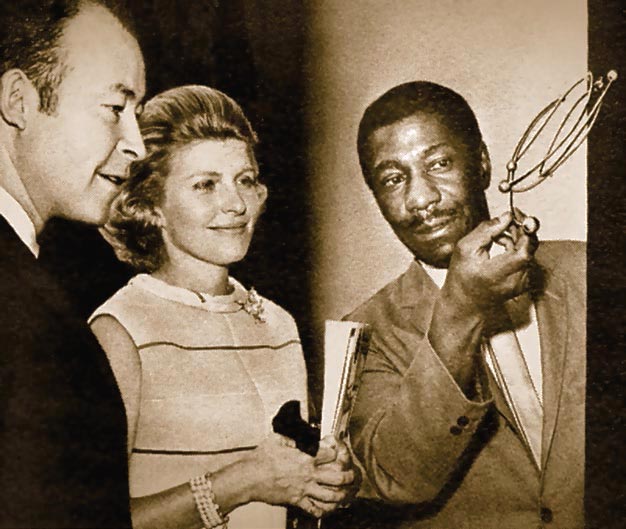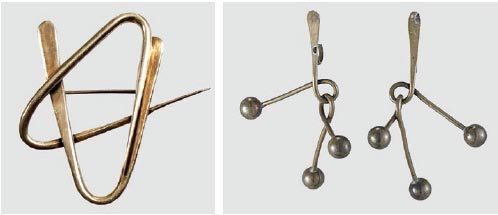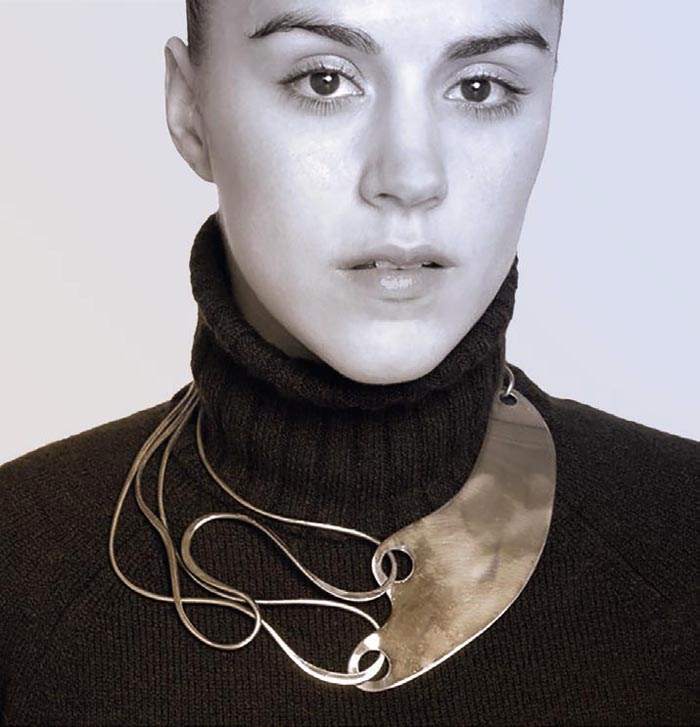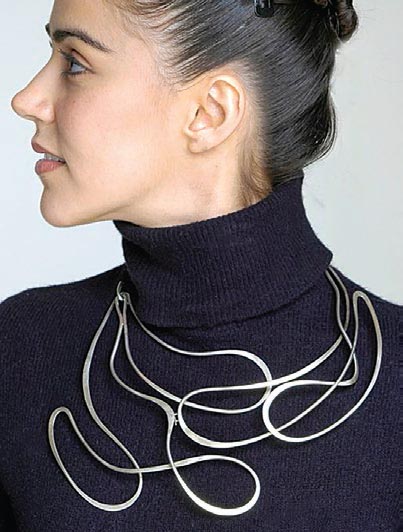Caressing Spirit - Page 3
 |
|
|
Still, Smith didn't have to go big or bold to have fun. A popular, early (1949) product was his 'Moballs,' brass earrings featuring small, planet-like globes. These were, Russell writes, "a stylish accent at low cost."
"One of these earrings could be turned out in 15 or 20 minutes after the system was perfected," he wrote.
Smith was a fine technician, but that's not what he bragged about. Jewelers needed only a handful of skills, according to Russell, "using the jeweler's saw, soldering, setting stone, planishing metal and wire."
"More important," he went on, is to be open to "all kinds of form, line, excitement, serenity, emotion, glamour. It would be desirable to give yourself exercises in piousness, in religiousness. I mean—say to yourself—I want to design something so cold, so stunning, but so clean—so pure that a nun could wear it."
"A piece of jewelry is in a sense an object that is not complete in itself," Smith wrote for a 1969 catalog of a one-man exhibit at New York's Museum of Contemporary Craft. "Jewelry is a 'what is it?' until you relate it to the body. The body is a component in design just as air and space are. Like line, form, and color, the body is a material to work with. It is one of the basic inspirations in creating form."
 |
|
|
Smith treated space—the space around the forms of his jewelry, the space between the jewelry and the neck, ears, or other parts of the wearer's body—as part of his design. And he liked to point out that, unlike metal or stones, space was free.
After he graduated from Cooper Union in 1940, Smith then worked in youth education. He was rejected by the draft board due to a heart murmur. He moved from Brooklyn to a cheap apartment in the Village in 1946, and started his own studio after leaving Winnie Mason.
His first studio was in a contested location just south of the Village, where racist and homophobic neighbors drove him out. It made headlines, and the NAACP stepped in to help. "They were breaking my windows, and there was an attempt made to run me over," Smith recalled in the 1971 interview.
By 1948 Smith was already gaining fame, his work included in a national contemporary jewelry exhibit in Minneapolis. Throughout his career Smith's work would be included in significant exhibits. He was also a popular lecturer.
 |
Smith, who had suffered a heart attack in 1969, the year his art was celebrated with the one-man show at the Museum of Contemporary Craft, suffered from congestive heart failure in 1977 and shuttered his shop.
He would continue to work from his home, a loft in SOHO, which he shared with Charles Russell. But his output was small, mostly for longtime clients, many of whom had become friends.
Smith died of heart disease in 1982 at age 65. Among the performers at his funeral was jazz pianist Randy Weston, who included Ellington and Strayhorn in his musical set.
Throughout his career, Smith designed jewelry for specific people, often friends, inspired by something about each person. One recipient was, yes, a nun.
 |
Karen Daley was a Catholic sister who had recently visited from Rhode Island. For her, Smith used thick sterling-silver wire and small stones of carnelian, lapis lazuli, garnet, coral, jade, and tiger's eye to create 'Sister Silver,' a neckpiece of sinuous, interlocking, asymmetrical curves suggesting irreverent merriment.
"When he showed it to Sister Karen, when she came for another visit," Charles Russell wrote, "she broke into serious laughter, proclaiming that she would never be allowed to wear such a thing. But she loved the idea."
• The book Art as Adornment: The Life and Work of Arthur George Smith (2015) by Charles L. Russell is available from Outskirts Press
Photography: courtesy Estate of Art Smith, Mark McDonald, Brooklyn Museum (Gift of Charles L. Russell), Auerbach & Maffia, Rico Tee Archive
- « first
- ‹ previous
- 1
- 2
- 3




